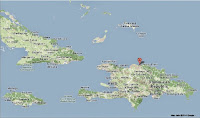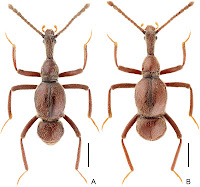The Barbary Sheep (or
Aoudad), Ammotragus lervia,
is a wild Caprid found in North Africa, from the Mediterranean as far
south as the Niger and Lake Chad, and introdiced to other parts of
the world such as North America and the Canary Islands. The species
is now missing from much of its original range, having suffered from
habittat loss Human encroachment, overhunting and competition with
domestic animals, and is considdered Vulnerable under the terms of
the International Union for the Conservation of Nature's Red List of Threatened Species. This has led to a number of recent studies of the
species popuation and distribution, but other aspects of its biology
have tended to be overlooked. In Tunisia the species is nearly
extinct and considdered tobe Critically Endangered under the National
Register of Wild Species.
In a paper published in
the South African Journal of Science on 23 November 2015,
Jamel Ben Mimoun and Saïd Nouira of the Laboratory of Animal Ecology
at the Tunis El Manar University discuss the results of a study of
the diet of the Barbary Sheep in the Bou Hedma National Park in
central Tunisia.
Barbary Sheep, Ammotragus lervia, at Oued Dekouk in Tunisia. Steve Morgan/Mammal Watching.
Ben Mimoum and
Nouira examined Barbary Sheep droppings collected at monthly
intervals between March 2009 and February 2010 in order to determine
the proportions of different plants in the diet of the living
animals. They found that two species of Grass, Stipa
parviflora and Stipa
tenacissima, formed the bulk of
the Sheep's diet, together forming 63.2% of the plant matter
consumed. However there was a strong seasonal variation in the amount
of these Grasses consumed, so that they formed 69.1% of the diet in
spring, 78.3% of the diet in summer, 56.6% of the diet in autumn and
34.7% of the diet in winter.
Thus Grasses form the
bulk of the plant matter consumed in spring and summer (though the
maximum number of different plant species were consumed in spring),
In autmn browsing on trees and shrubs played a more important part in
the diet, with Pistacia lentiscus comprising 7.4% of the plant
matter consumed, Juniperus phoenicea 5.9% and Periploca
laevigata 5.2%. Periploca laevigata remained an important
part of the diet in winter, forming 5.5% of the diet. The herbaceous
plant Helianthemum kahiricum was also important in autumn and
winter, when it formed 13.6% and 13.0% of the diet, with two other
herbaceous plants becoming important in winter; Globularia alypum,
which formed 14.6% of the winter diet, and Helianthemum
semiglabrum, which formed 12.1% of the winter diet.
The current distribution of the Barbary Sheep, Ammotragus lervia, in North Africa. International Union for the Conservation of Nature's Red List of Threatened Species.
The Barbary Sheep is a
highly flexible herbivore, known to be able to consume a wide range
of plant species. In Texas, where it has been introduced, it has been
shown to regularly consume 25 species of plants, in the Canaries 41,
and in New Mexico 74 species. In Bou Hedma the species only consumed
19 identifiable species of plants, which is likely to be a result of
a lack of suitable alternatives rather than a lack of willingness to
consume other plants. Nevertheless the Tunisian Barbary Sheep shows a
clear preference for Grasses when these are available, something
which has previously been observed in Barbary Sheep in Texas and
California, though other studies of the Sheep in Texas, New Mexico
and Morocco have found browsing on trees and shrubs to play a more
important role in the species diet. It was noted that the Tunisian
Sheep showed a clear preference for open grassland during the
breeding season, and that this was also the time of maximum Grass
growth.
See also...
 Mapping the distribution of the Southern Pudú in Chile. The Southern Pudú, Pudu pudu, is one pf the world's smallest
Deer species, typically weighing 35 to 45 cm at the shoulder and
weighing 6.4 to 13.4 kg. It is found in southern Chile and Argentina,
and is listed as...
Mapping the distribution of the Southern Pudú in Chile. The Southern Pudú, Pudu pudu, is one pf the world's smallest
Deer species, typically weighing 35 to 45 cm at the shoulder and
weighing 6.4 to 13.4 kg. It is found in southern Chile and Argentina,
and is listed as... How fencing the Tibetan prairies is effecting the endangered Przewalski’s Gazelle. The Przewalski’s Gazelle (Procapra przewalskii) is a species of
high altitude adapted Antelope, which formerly ranged across much
of northwestern China and Inner Mongolia. It is now restricted to a
small area around Qinghai Lake on the Tibetan Plateau, with a...
How fencing the Tibetan prairies is effecting the endangered Przewalski’s Gazelle. The Przewalski’s Gazelle (Procapra przewalskii) is a species of
high altitude adapted Antelope, which formerly ranged across much
of northwestern China and Inner Mongolia. It is now restricted to a
small area around Qinghai Lake on the Tibetan Plateau, with a...
Follow Sciency Thought's on Facebook.









































